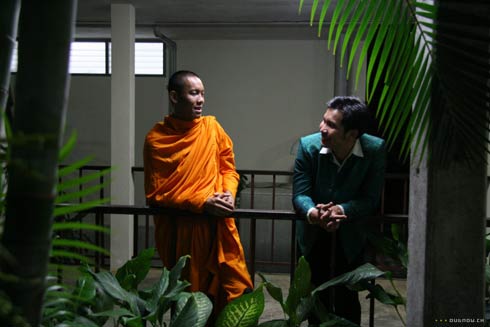Syndromes and a Century

Writer/director Apichatpong Weerasethakul ("Blissfully Yours," "Tropical Malady") chooses the mirror approach for the third time as he explores the mysteries of memory through his own remembrance of his physician parents, imagined before they were lovers, in "Syndromes and a Century."
Laura's Review: A-
This gentle film with surprising dollops of humanistic humor floats by like a dream upon which we are eavesdropping. The first half, which observes Weerasethakul's mother, Dr Toey (Nantarat Sawaddikul), takes place at a Thai country hospital where the natural world and natural light abound. The second half, which begins a near identical scene and near identical dialogue, focuses on the director's father, Dr. Nohng (Jaruchai Iamaram), in a sterile city hospital in contemporary times. Although the film starts with mother/nature, it is emphatically from dad's point of view. Dr. Toey is seen giving a psychological exam to the serious-faced Nohng, humorously describing himself as cheerful. On the sidelines, another patient, Toa (Nu Nimsomboon), tries to woo his doctor with gifts. Toey sees an old monk (Sin Kaewpakpin) who dreams of vengeful chickens and tries to persuade Toey to dispense drugs for his entire temple, attempts to shame a colleague into paying back a debt and remembers an orchid collector, Noom (Sophon Pukanok), who took a rare tree specimen from the hospital grounds back to his farm with Toey. The old monk's companion, Sakda (Sakda Kaewbuadee, "Tropical Malady"), visits a dentist, Dr. Ple (Arkanae Cherkam), and they discover a shared and atypical love of music. At the film's midpoint, we return to that original scene, or so Weerasethakul makes us believe, until we notice we are now seeing Nohng from Toey's point of view and the lighting is cold, the background white. The father/industrial half of the film repeats much from the first half, although there are twists - Sakda's dentist visit has no dialogue, and the colleagues Nohng finds in the hospital basement - Dr. Nant (Wanna Wattanajinda), who volunteers for the Red Cross, and Dr. Wan (Wanna Wattanajinda), who keeps her Scotch hidden in a prosthetic leg to cure her nerves before television appearances, are more colorful than the debtor in the garden. Weerasethakul moves his camera little, which makes his occasional use of the tracking shot almost transcendent. Early on the camera floats out of Toey's office window, taking in the pristine grounds and mountains beyond (we hear her gossiping with another doctor on her way out). Later, the camera follows a legless man making his way down a shiny, sterile corridor, and we get the impression he's wading through water, fine work by cinematographer Sayombhu Mukdeeprom ("Mysterious Object at Noon," "Blissfully Yours"). The clear circle Nohng chooses as his favorite geometric shape is suggested in the background of his segment. The cast is made up largely of amateurs (Sakda Kaewbuadee is the exception) but they all establish indelible characters played with natural ease. Apichatpong Weerasethakul has woven his own youthful memories of people and places with his current experience and the world he presents us is a welcoming one. "Syndromes and a Century" wafts like a cloud and lulls us into its peaceful rhythms.
Robin has not finished his review of this film.
Robin's Review: NYR
NYR

